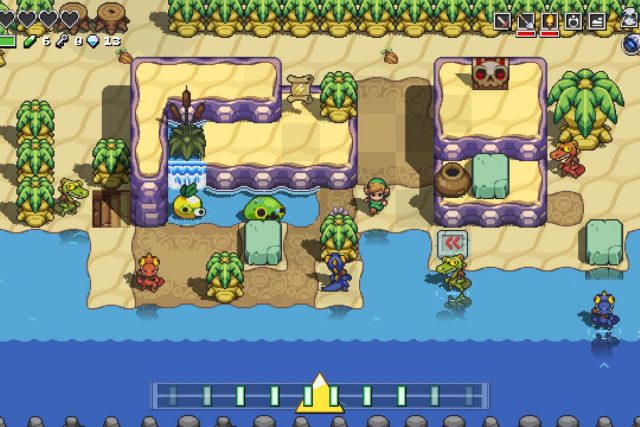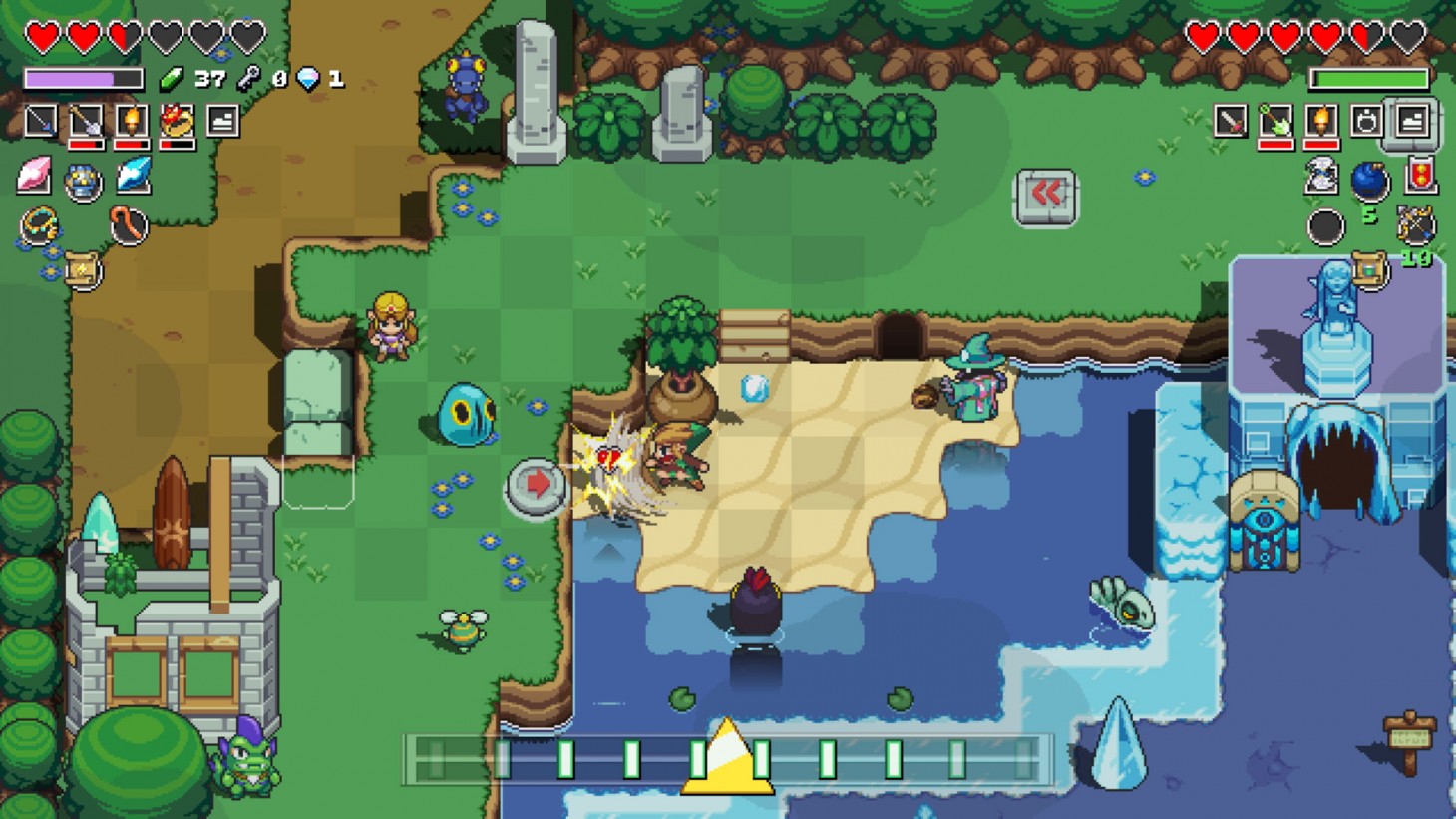The Legend of Zelda series has many hallmarks: dungeons, finding a sword and shield, exploring vast and untamed lands, and saving the princess, of course, not to mention the many, many others.
One of the series’ hallmarks that is often lauded is the way that the game changes from one iteration to the next. Twilight Princess and Skyward Sword were vastly different entries in the franchise, despite being released on the same system. While Ocarina of Time and Majora’s Mask were built in the same engine using many of the same assets, their story took completely different turns, the latter introducing a three day system that completely changed the gaming loop of the game, and a mask mechanic that unlocked certain areas and abilities in ways we hadn’t yet seen in the series.
Luckily, the virtue of changing the game nearly every time means that the series has already been proven successful in adapting to different play and art styles. Enter Cadence of Hyrule: Crypt of the NecroDancer ft. The Legend of Zelda.

Long title aside, Cadence of Hyrule is a sort of re-skin on the original Crypt of the NecroDancer game, but calling it just a re-skin would be doing a disservice to what Brace Yourself Games has been able to accomplish here. A huge disservice.
In fact, Cadence of Hyrule is one of the biggest breaths of fresh air the Zelda franchise has seen for its non-main storyline titles in a long while. A Link Between Worlds was a great game, but with other misses like Triforce Heroes and Hyrule Warriors, the franchise could always use with a little fresh take in its stable.
For those who haven’t played Crypt, the game plays with rhythm as a movement mechanic. You control the player character around the map on the beat in order to string together combos. Enemies must follow the same rhythm, and when everyone is moving on beat, there’s a player vs. enemy dance going on that is quite entertaining.
At the outset of Cadence of Hyrule, you learn that Link and Zelda, alongside the King of Hyrule, have been put to sleep by Octavo, the evildoer of this world, and just the first of many musically-named enemies.
A familiar story, sure, but it takes a different path when you are able to choose who to awaken. Naturally, if you awaken Link, you play as our green-capped friend, but if you awaken Zelda, you have the opportunity to finally play as the series’ namesake princess. And this isn’t just a sprite change. Zelda has her own abilities and finds her own unique weapons, but we don’t want to spoil much, so we’ll just leave that thought there.
Gameplay sees you traversing the map (which is broken up into square-ish sections that slide to the next when you reach their edges, A Link to the Past style), defeating a set series of enemies in each area. The map is partially procedurally-generated, so you won’t technically see the same map twice, and the positioning of different landmarks like Fairy Fountains will change between gameplay.

You’ll find yourself slashing bushes for rupees and power-ups, new weapons, and plenty of shovels, used in every bit of the game to uncover new areas and secrets. There is a bunch of charm here, including hidden staircases beneath bushes, cuccos (and cucco attacking), and bottle collecting mechanics that help make this a bona fide Zelda experience.
And yet, with all that, it’s still not too much. The game feels appropriately paced (or, rather, on rhythm) and doesn’t ever overstay its welcome. You could probably beat the whole thing in a couple of sittings if you wanted to, and you can most certainly beat it without visiting every area, but there are loads of things to see, and they’re all very much worth seeing. Visit the Gerudo and play a bombchu mini-game, have a swim through some lava to collect an extra heart piece, and bomb the heck out of walls to reveal hidden caverns and shops.
While you’re at it, bomb the shopkeeper himself and you’ll be up for a real challenge with a satisfying reward, should you actually manage to take him down!
The music in Cadence of Hyrule is probably the most notable of any in the series. There isn’t anything new here–and that’s by design–but every song you know and love from the series has been remixed and remastered in a way that will have you head bopping along to the tunes in a way that is completely unexpected for a Zelda game. And when you get into the rhythm of the game, being on beat becomes completely second nature and entirely empowering.
While difficulty tends to ramp up in most Zelda games, Cadence of Hyrule actually got easier as things progressed. Since the rhythm mechanic is not something we’ve really dealt with since, well, Guitar Hero and Rock Band, it took a good hour plus of play time to get used to. And don’t even think about playing this without sound or with the TV in the background; you’re bound to be off rhythm the entire game.
The difficulty ramp, or rather slide, actually becomes more apparent because of the overpowered weapons you’re given. Our favourite, one of the many spears, would attack enemies from two tiles away, poison them (which causes them to lose health on every other subsequent beat of the music), and healed half a heart for every five enemies we killed. It became too easy to stand in one spot with a series of enemies stuck in a doorway, so nothing could move towards you, and just poke on beat until we’d cleared the room.
The dungeon and final bosses were quite simple as well, especially once you factor in potions that instantly heal you when you reach zero hearts, or fairies that give you five hearts back. (Pro tip: just use the potions, they’ll refill you completely.)

And that’s probably the only real annoyance with the game, is that it becomes too easy. But really, if you’re looking for a more difficult version, just un-equip the heavy duty weapons and use the little swords. But not the Kokiri sword. Because you get that at the end, and it’s somehow one of the strongest ones in the game. despite everything we’ve been taught about the Kokiri sword in every other Zelda game before.
Cadence of Hyrule: Crypt of the NecroDancer ft. The Legend of Zelda, is a wonderful experience and a unique departure from other, more traditional Zelda titles. Perhaps most notably, however, is that it is a game completely worthy of the name The Legend of Zelda. In fact, it could have been called The Legend of Zelda: Cadence of Hyrule, and we could have been told it was developed, produced, and published by Nintendo, and we’d have believed it.
Brace Yourself Games has shown that an indie studio can absolutely shine when given the license to one of the most beloved gaming franchises in history, and that they were able to do it even by marching to the beat of their own drum.
.
This review was based on a copy of the game provided by Nintendo. Click here to read our review policy.

